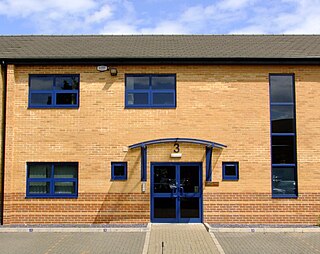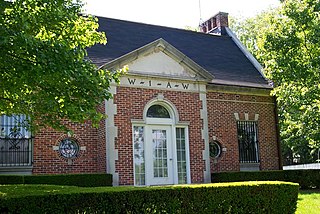
Morse code is a telecommunications method which encodes text characters as standardized sequences of two different signal durations, called dots and dashes, or dits and dahs. Morse code is named after Samuel Morse, one of the early developers of the system adopted for electrical telegraphy.
The Q-code is a standardised collection of three-letter codes that each start with the letter "Q". It is an operating signal initially developed for commercial radiotelegraph communication and later adopted by other radio services, especially amateur radio. To distinguish the use of a Q-code transmitted as a question from the same Q-code transmitted as a statement, operators either prefixed it with the military network question marker "INT" or suffixed it with the standard Morse question mark UD.
The American Radio Relay League (ARRL) is the largest membership association of amateur radio enthusiasts in the United States. ARRL is a non-profit organization and was co-founded on April 6, 1914, by Hiram Percy Maxim and Clarence D. Tuska of Hartford, Connecticut. The ARRL represents the interests of amateur radio operators before federal regulatory bodies, provides technical advice and assistance to amateur radio enthusiasts, supports a number of educational programs and sponsors emergency communications service throughout the country. The ARRL has approximately 161,000 members. In addition to members in the US, the organization claims over 7,000 members in other countries. The ARRL publishes many books and a monthly membership journal called QST.

The Radio Society of Great Britain (RSGB) is the United Kingdom's recognised national society for amateur radio operators. The society was founded in 1913 as the London Wireless Club, making it one of the oldest organisations of its kind in the world. Through its work, it represents the interests of the UK's 80,000 licensed radio amateurs in the United Kingdom and certain dependent territories of the United Kingdom at the International Amateur Radio Union, acting as a medium for communication between the licensed operators and the UK government.

Amateur radio international reciprocal operating agreements permit amateur radio operators (hams) from one country to operate a station whilst traveling in another without the need to obtain additional licenses or permits.

In the United States, amateur radio licensing is governed by the Federal Communications Commission (FCC). Licenses to operate amateur stations for personal use are granted to individuals of any age once they demonstrate an understanding of both pertinent FCC regulations and knowledge of radio station operation and safety considerations. There is no minimum age for licensing; applicants as young as five years old have passed examinations and were granted licenses.

W1AW is both the amateur radio call sign and the primary operating station of the American Radio Relay League (ARRL). This station, which is commonly called the Hiram Percy Maxim Memorial Station, is located on the grounds of ARRL Headquarters in Newington, Connecticut. It was inspired by Maxim's 1AW callsign which predated the use of the AA-AL, K, N and W prefixes. The station routinely transmits bulletins and Morse code practice using common amateur radio frequencies. During a communications emergency bulletins are transmitted hourly in order to keep amateur radio operators informed.

The Trinidad and Tobago Amateur Radio Society, Inc. (TTARS) is the national amateur radio organization in the Republic of Trinidad and Tobago. It is a member society of the International Amateur Radio Union (IARU).
The Shuttle Amateur Radio Experiment (SAREX), later called the Space Amateur Radio Experiment, was a program that promoted and supported the use of amateur ("ham") radio by astronauts in low Earth orbit aboard the United States Space Shuttle to communicate with other amateur radio stations around the world. It was superseded by the Amateur Radio on the International Space Station (ARISS) program. SAREX was sponsored by NASA, AMSAT, and the ARRL.
The history of amateur radio, dates from the dawn of radio communications, with published instructions for building simple wireless sets appearing at the beginning of the twentieth century. Throughout its history, amateur radio enthusiasts have made significant contributions to science, engineering, industry, and social services. Research by amateur radio operators has founded new industries, built economies, empowered nations, and saved lives in times of emergency.
Amateur radio or ham radio is practised by more than 22,000 licensed users in India. The first amateur radio operator was licensed in 1921, and by the mid-1930s, there were around 20 amateur radio operators in India. Amateur radio operators played an important part in the Indian independence movement with the establishment of illegal pro-independence radio stations in the 1940s. The three decades after India's independence saw only slow growth in the number of operators until the then Prime Minister of India and amateur radio operator, Rajiv Gandhi (VU2RG), waived the import duty on wireless equipment in 1984. Since then, numbers have picked up, and as of 2007, there were more than 16,000 operators in the country. Amateur radio operators have played a vital role during disasters and national emergencies such as earthquakes, tsunamis, cyclones, floods, and bomb blasts, by providing voluntary emergency communications in the affected areas.
The Irish Radio Transmitters Society (IRTS) is a national non-profit organization for amateur radio enthusiasts in Ireland. Key missions of the IRTS include promoting amateur radio experimentation and representing the interests of Irish amateur radio operators before Irish and international telecommunications regulatory authorities. In particular, since 2005 in agreement with Communications Regulator (Comreg), the IRTS supports the entire examination process for the Experimenter's Licence including setting, organising, and correcting examinations for the Irish amateur radio license. The organization has no paid employees, and all tasks are performed by volunteers. IRTS is the national member society representing Ireland in the International Amateur Radio Union.
The Chinese Radio Sports And Orienteering Association (CRSAOA) is a national non-profit organization for amateur radio enthusiasts in the People's Republic of China. The CRSA's primary mission is to popularize and promote amateur radio in China. Early activities of the organization focused on radiosport, and the CRSA was active in promoting Amateur Radio Direction Finding and High Speed Telegraphy competitions throughout the country. Although the CRSA has broadened its scope and now supports many kinds of radio activities, the organization's name continues to reflect this early heritage. Key membership benefits of the organization include QSL bureau services, a quarterly membership magazine called Ham's CQ. CRSA was also responsible for the administration of the amateur radio license certification program in the People's Republic of China until 2010.Former Chinese Radio Sports Association.

Amateur radio, also known as ham radio, is the use of the radio frequency spectrum for purposes of non-commercial exchange of messages, wireless experimentation, self-training, private recreation, radiosport, contesting, and emergency communications. The term "amateur" is used to specify "a duly authorized person interested in radioelectric practice with a purely personal aim and without pecuniary interest" ; and to differentiate it from commercial broadcasting, public safety, or professional two-way radio services.
Call signs in the Middle East are unique identifiers for telecommunications and broadcasting in the Middle East. Call signs are regulated internationally by the International Telecommunication Union (ITU) and nationally by local government and international agencies in Israel, Jordan, Lebanon, Syria, The Palestinian Authority, occupied territories and other nations or DXCC entities.
Amateur radio call signs are allocated to amateur radio operators around the world. The call signs are used to legally identify the station or operator, with some countries requiring the station call sign to always be used and others allowing the operator call sign instead.
Call signs in Korea are unique identifiers for telecommunications and broadcasting on the Korean peninsula. Call signs are regulated internationally by the ITU as well as nationally in South Korea by the Korea Communications Commission in the Ministry of Information and Communication. Not much is known outside of North Korea how amateur radio is regulated, although a foreign amateur was asked to appear before the "Radio Regulation Board" in 2002. Also, North Korea's Cultural Relations with Foreign Countries recently issued an operating permit, which was countermanded by the Ministry of Telecommunications and Posts.
Call signs in Europe are not formally used for broadcast stations.
Call signs in Antarctica include a three letter region code and a series of numbers and letters.
Call signs in United Kingdom include a three letter country code, and a series of letters and numbers.












